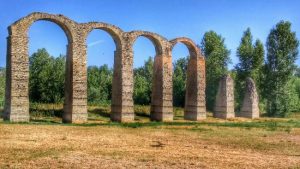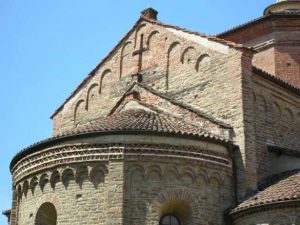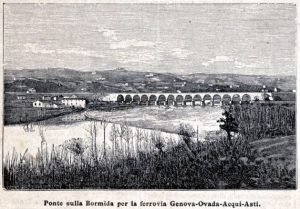
“Arte et Marte”
The Municipal Coat of Arms, already adopted between the end of the XIII century and the beginning of the XIV by the Municipality of Acqui, consists of a shield divided into two fields, the upper one (which wants to remember, as claimed by the Acquesi historians including the Biorci, the participation of Acqui alle Crociate) in silver with a red cross, the lower one in gold with a black eagle holding a natural colored hare in its claws, all surmounted by a count crown. The shield embraces laurel and wheat leaves with a blue ribbon bearing the motto: Arte et Marte. The most accredited interpretation of the motto is "with ingenuity and strength [the City is defended]".
"Name origin"
The current name derives from the Latin name Aquae Statiellae that the Romans attributed to the city they founded, in the territory of the Liguri Statielli, around the thermal springs, in the 2nd century BC. From late antiquity it appears as Aquis which in the vernacular will then be Acqui. With the decree of the President of the Republic of 16 March 1956 the term Terme is added. In local dialect the city is known as Aich ', Oich in Piedmontese.

"Liguri Statielli"
The first traces of human presence on the Acquese territory date back to the Neolithic period. In the protohistoric age the Ligurian Statielli settled in our territory. Of their center, Carystum, we know nothing except that he was besieged and destroyed by the Romans of the consul Marco Popilio Lenate in 173 BC. The conquest was followed by the progressive Romanization of the territory and its inhabitants and by the birth of a new city, Aquae Statiellae, around the thermal springs.

"The Roman age"
After 109 BC, with the construction of Via Aemilia Scauri, Acqui Terme experienced an economic and social flourishing that continued at least until the 2nd century. AD The archaeological research has returned the image of a monumental city, with thermal plants, the theater, the amphitheater, commercial emporiums and the aqueduct, animated by a fervent commercial, artisan and industrial activity. This picture is confirmed by the Latin historians who cite Acqui and its thermal baths (Pliny counts them among the best in the empire).

"The Lombard dominion"
The general crisis of the fourth century also affects Acqui: the city, though reduced, survives difficult moments thanks to the presence of authoritative bishops. At the end of the 6th century, Acqui, like other cities of present-day Piedmont, was conquered by the Lombards, probably entering the Duchy of Asti. Also in this period, according to the testimony of the historian Paolo Diacono, the baths are still in activity.

"The Aleramic March"
In the empire of the Franks, Acqui became the seat of a committee which, in the 10th century, together with the Vado-Savona committee, constituted the brand entrusted to Aleramo. Also important is the role exercised by the Church, not only on a spiritual level but also on a political and economic level: in 978, Emperor Otto II entrusted the bishop with the government of the city and of the immediate district which came to constitute an enclave within the Aleramic brand. In the same years, still for the episcopal initiative, the construction of the Cathedral began, entitled to the Assumption; the bishop Guido will consecrate it in 1067 (solid moral and civil guide of Acqui in the XI century, honored as Saint and patron of the city). The first city wall that embraces the upper part of the city is also an episcopal initiative, leaving out the source of boiling water and the Benedictine abbey of San Pietro.

"Municipalities"
During the twelfth century municipal institutions developed (the first certain attestation dates back to 1135).The City did not have an easy life, opposed in the city by the rivalry with the episcopal political power and, externally, by the interests of the noble families (marquises of Ponzone, of the Bosco, of the Carretto and of Monferrato) and of the greater municipalities (Alba, Asti, Genoa , Savona).
The foundation of Alexandria (1168) determined the crisis of both institutions of Acqui: the Municipality was suffocated by the arrogance of the young neighbor and the diocese even risked being absorbed by the new headquarters of Alexandria. The vicissitudes of war in Piedmont in the 13th century did not resolve the difficulties of the city which, in 1278, wanted to ensure greater stability by joining the marquisate of Monferrato, within which, however, it maintained a certain capacity for self-government.

"Middle ages"
Del Monferrato, Acqui followed the events, passing to the Paleologos (successors of the Aleramici) in 1305. The fourteenth century, between wars and plague, was a troubled century, however the expansionism of the Visconti did not remove Acqui from Monferrato. A more favorable situation occurred in the fifteenth century: the greater solidity of the Monferrato state (reflected in the rebuilding of the castle and in the expansion of the walls) and the development of the port of Savona allowed the flourishing of trade: a prosperity evidenced by the architectural aspect ensued of civil and religious buildings which still have 15th century features. Even the baths, whose activity was never interrupted, were involved in the general recovery: in 1435 the waters of Nicolò d'Este came to pass and frequent were the stays of the Paleologos.

"Renaissance"
In Monferrato Acqui following the events, has passed to the Paleologos (successors of the Aleramici) in 1305. The fourteenth century, between wars and plague, was a troubled century, however the expansionism of the Visconti did not remove Acqui from Monferrato. A more favorable situation occurred in the fifteenth century: the greater solidity of the Monferrato state (reflected in the rebuilding of the castle and in the expansion of the walls) and the development of the port of Savona allowed the flourishing of trade: a prosperity evidenced by the architectural aspect ensued of civil and religious buildings which still have 15th century features. Even the baths, whose activity was never interrupted, were involved in the general recovery: in 1435 the waters of Nicolò d'Este came to pass and frequent were the stays of the Paleologos.

"Pre risorgimento"
In 1708 Acqui, with all the Monferrato, was assigned to the Savoy, becoming part of a modern state governed by enlightened despotism. Important public works were promoted such as the diversion of the Rio Medrio out of the city and the military spas. The institution of the ghetto gathers, in the center of the city, the large and ancient Jewish community.
At the end of the eighteenth century the revolutionary message, and with it the Armeé, also reached Acqui: Napoleon Bonaparte stopped here in 1796. The imperial government was mainly responsible for the construction of the Savona-Acqui-Alessandria road.

"Savoy State"
In the nineteenth century the population experienced a marked increase that involved the demolition of the walls and urban development. With the construction of the Carlo Alberto bridge, a direct connection is traced with the Oltrebormida and its thermal springs.
The first railway line connects Alessandria to Acqui in 1858; then those for Savona (1870), Asti and Genoa (1893) will follow. In these years the ghetto was demolished giving a new structure to the Piazza della Bollente.

"Modern Age"
The end of the century is perhaps the most brilliant period of Acquese spas that lasted until the Second World War. New theaters and casinos enliven social life; in Acqui there are the Nuove Terme. In the 1930s there was an expansion of the thermal structures favored by the state initiative: the one that, for a long time, will remain the largest swimming pool in Europe is also built.
In the meantime, some industrial activities also arise, such as the Bordoni MIVA glassworks (whose activity ceased in 2000) and other minor ones in the manufacturing and wine sector. After the war both the baths and the local industries marked a strong setback. A reversal of the trend, in the thermal area, has been recorded for some years, accompanied by various interventions for the recovery of the historic center.
Questo contenuto è disponibile in:


